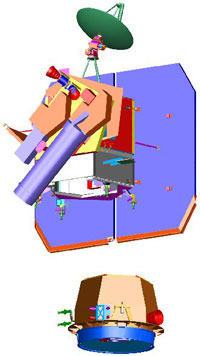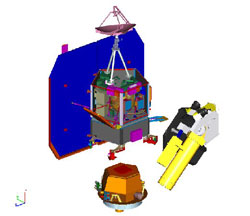
The Flight System is about 3.3m long, 1.7m wide, and 2.3m high.
The flight system consists of two spacecraft: the flyby spacecraft and the impactor. Each spacecraft has its own instruments and capabilities to receive and transmit data.
The flyby spacecraft carries the primary imaging instruments (the HRI and MRI) and the impactor (with an ITS) to the vicinity of the comet nucleus. It releases the impactor, receives impactor data, supports the instruments as they image the impact and resulting crater, and then transmits the science data back to Earth.
The impactor guides itself to hit the comet nucleus on the sunlit side. The energy from the impact will excavate a crater approximately 100m wide and 28m deep.
The instruments help guide both spacecrafts and then acquire the science data that will be analyzed by the science team.

Main Goals of the Flight System:
- Hit nucleus of Tempel 1 with sufficient kinetic energy to form a crater with a depth > 20m
- Observe nucleus for > 10 minutes following impact
- Image nucleus impact, crater development and inside of crater
- Obtain spectrometry of nucleus and inside of crater
- Acquire, store, format, and downlink imagery and spectrometry data












